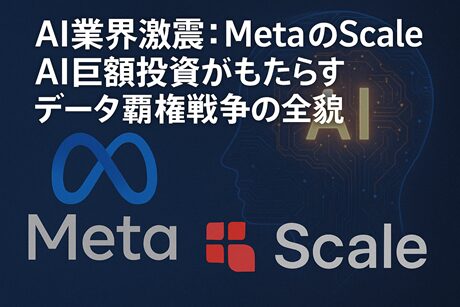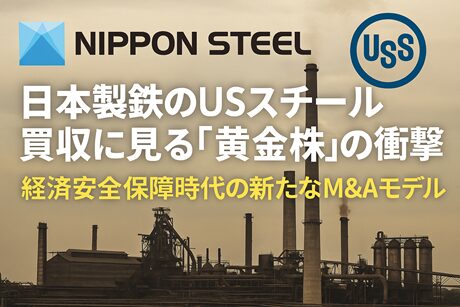目次
- 1 Meta’s $14B Scale AI Deal Reshapes AI Data Wars
- 1.1 What is Scale AI: The Company Holding the Lifeline of AI Development
- 1.2 Meta’s Scale AI Acquisition: A New Phase in AI Competition and Comprehensive Strategy
- 1.3 OpenAI and Google’s Response: The End of Partnerships and Their Background
- 1.4 Impact on the AI Industry: Ecosystem “Balkanization” and New Competitive Structure
- 1.5 Overall AI Market Trends and Future Outlook
- 1.6 Implications for Japanese Companies: Facing the “2025 Cliff”
- 1.7 Conclusion: Strategic Implications in the New Era of AI Development
Meta’s $14B Scale AI Deal Reshapes AI Data Wars
In June 2025, the AI industry witnessed an unprecedented seismic shift. Meta Platforms (formerly Facebook) invested a staggering $14.3 billion (approximately ¥2.1-2.3 trillion) in Scale AI, the leading AI data labeling company, acquiring 49% of its shares. This move prompted two AI giants, OpenAI and Google, to swiftly terminate their partnerships with Scale AI.
This series of events represents more than just corporate transactions. It symbolizes a historic turning point where the main battleground of AI development competition has clearly shifted from model algorithms and computational power to the underlying “data hegemony.”
What is Scale AI: The Company Holding the Lifeline of AI Development
To understand this upheaval, we must first comprehend Scale AI’s role in the AI ecosystem. Founded in San Francisco in 2016, Scale AI is a unicorn company (unlisted venture valued over $1 billion within 10 years of establishment) with a mission to “accelerate AI development.” The company’s valuation now exceeds $29 billion (approximately ¥4.1 trillion) following this investment.
The Critical Importance of Data Labeling (Annotation)
Scale AI provides data labeling (annotation) services, which involve adding “correct answer” labels and annotations to raw data (images, text, audio, video, etc.) by human annotators. This labeled data becomes “training data” that serves as learning material for AI models to behave appropriately.
AI prediction and analysis accuracy is determined by the quality of training data. The industry saying “Garbage In, Garbage Out” emphasizes that preparing accurately annotated, high-quality data is extremely crucial.
Types of Data Labeling and Specific Examples
Scale AI’s data labeling services fall into five major categories:
1. Audio Classification
Involves audio collection, segmentation, and transcription. Examples include emotion analysis from call center audio data or creating training data for voice assistants.
2. Image Labeling
Includes image collection, classification, segmentation, and keypoint data labeling. Specific examples:
- Classifying human facial images by emotion type (joy, sadness, anger, surprise, etc.)
- Categorizing road images into regions like “person,” “car,” “bicycle,” “traffic light”
- Identifying and marking tumors or abnormalities in medical images
3. Text Labeling
Text extraction and classification. Examples include:
- Categorizing news articles (politics, economy, sports, entertainment, etc.)
- Sentiment analysis of social media posts (positive, negative, neutral)
- Extracting product features and issues from customer reviews
4. Video Labeling
Video collection, classification, and segmentation. Examples:
- Labeling surveillance footage to detect abnormal behavior
- Classifying player movements and play types in sports videos
- Tracking human joints and movements frame by frame
5. 3D Labeling
Object tracking and segmentation in 3D space. Primarily used for autonomous vehicle LiDAR data and 3D environment recognition for AR/VR applications.
Types of Annotation
Scale AI also provides advanced annotation techniques including:
- Semantic Annotation: Assigning meaning to words in text. For example, determining whether “Apple” refers to the company or the fruit based on context.
- Image/Video Annotation: Tagging to accurately understand image and video content. Includes object detection, region segmentation, and pose estimation.
- Text and Content Classification: Assigning free text to defined categories. Used for spam filtering and automatic document sorting.
- Intent Extraction: Tagging user intent at phrase or sentence level for chatbots to accurately understand user intentions. Identifies intents like “want to know product price,” “want to return,” “need technical support.”
Data Labeling Methods and Challenges
Scale AI and other data labeling companies provide services through the following methods:
- Internal Labeling: Performed by company IT departments or dedicated staff. Ensures high security but requires sufficient resources.
- Synthetic Labeling: Generates new data from existing datasets. Requires less manual work and produces high quality but needs advanced computational power and expertise.
- Programmatic Labeling: Uses automated scripts to detect and label data. Efficient but risks incorrect labeling and requires verification.
- Outsourcing: Delegates to external specialists. Efficient but quality depends on contractor skills.
- Crowdsourcing: Leverages specialists through cloud services. Easy to scale but quality control becomes challenging.
These methods share common challenges: they are “expensive and time-consuming” and “prone to human error.” Scale AI claims to provide reliable data by combining software with manual work, performing quality checks after automated processing.
Scale AI’s Customer Base and Market Size
Scale AI has earned tremendous trust from major AI industry players. Key customers include:
- OpenAI (developer of ChatGPT, DALL-E, GPT-4)
- Google (developer of search engine and Gemini AI)
- Microsoft (provider of Azure AI services and Copilot)
- Meta (operator of Instagram, Facebook, WhatsApp)
- Autonomous driving companies: Waymo, GM Cruise, Lyft, Toyota Research Institute, General Motors
- U.S. Department of Defense (using the security-focused “Donovan” platform)
Scale AI’s projected revenue for 2024 reached $870 million (approximately ¥130 billion), establishing its position as the leading company in the AI data labeling market. The company offers diverse services including GenAI platforms and security-focused solutions.
Meta’s Scale AI Acquisition: A New Phase in AI Competition and Comprehensive Strategy
On June 12, 2025, Meta announced it would invest $14.3 billion (approximately ¥2.14-2.3 trillion) in Scale AI, acquiring 49% of its shares. Some reports cite the figure as $14.8 billion. This investment values Scale AI at over $29 billion (approximately ¥4.1 trillion).
Recruiting Alexandr Wang and Strategic Intent
The most crucial element of this investment deal is that Scale AI’s founder and CEO Alexandr Wang will join Meta to lead its “Superintelligence” development team. Wang will continue serving as a Scale AI board member but will essentially become central to Meta’s AI strategy.
Mark Zuckerberg has shown strong interest in developing AGI (Artificial General Intelligence), and this investment is part of Meta’s clear strategy to establish a leading role in the AI industry. Meta positions this as an important strategic shift to strengthen AI technology, driven by concerns about falling behind in AI competition.
Meta’s Comprehensive AI Strategy
Meta’s AI strategy extends beyond the Scale AI investment. The company is deploying a multi-faceted approach including:
1. Massive GPU Server Purchases and In-House Chip Development
Meta is procuring large quantities of NVIDIA’s high-performance GPUs to improve AI advertising effectiveness, aiming to secure demand through around 2026. Simultaneously, to reduce dependence on NVIDIA and lower future costs, they’ve begun manufacturing their own AI chip called “MTIA.”
2. Building Sustainable AI Infrastructure
To improve sustainability in AI data center operations, Meta has signed geothermal energy contracts and is working on carbon-free energy utilization. This addresses the massive energy consumption required for AI computation.
3. Investment in Robotics
Meta announced a new world model called “V-JEPA 2,” which aims to improve robot flexibility and adaptability, enabling them to perform diverse tasks without human assistance.
4. Intensifying Talent Competition
Meta reportedly offers compensation ranging from millions to billions of yen to recruit AI researchers from OpenAI and Google DeepMind. However, OpenAI’s top talent hasn’t transferred. According to CEO Sam Altman, employees believe OpenAI has a higher probability of achieving AGI sooner.
5. Open Source Strategy
Meta has open-sourced its large language model “Llama,” accelerating developer community adoption. This aims to expand the ecosystem and democratize technology.
6. Promoting Vertical Integration
By strongly incorporating data creation capabilities that support AI development from external contractors into its own group, Meta is vertically integrating the AI development supply chain as a clear strategic shift to compete with rivals like OpenAI and Google. Securing “high-quality, large-scale training data” is considered essential for accelerating AGI (Artificial General Intelligence) and ASI (Artificial Superintelligence) development.
OpenAI and Google’s Response: The End of Partnerships and Their Background
Meta’s Scale AI acquisition sent ripples throughout the AI industry. OpenAI and Google, Scale AI’s major customers, took swift and decisive action.
OpenAI’s Strategic Response
OpenAI had been gradually reducing its dependence on Scale AI even before Meta’s investment announcement and decided to completely terminate the partnership following the acquisition. An OpenAI spokesperson explained this decision as seeking “other data providers that keep pace with innovation and understand what cutting-edge models require.”
This suggests OpenAI judged that Scale AI’s data creation capabilities couldn’t keep pace with or weren’t optimal for the evolution speed of state-of-the-art AI models.
OpenAI’s Current Status and Strategy
OpenAI is currently deploying the following strategies:
- $10 billion annual revenue achieved: Products like ChatGPT and DALL-E have gained wide acceptance and rapid growth.
- Strengthening enterprise strategy: Released the “o3-pro” model emphasizing reliability and accuracy while reducing the price of the high-performance “o3” model by 80%.
- ChatGPT integration strategy: Integrating features into a single entry point and deploying aggressive marketing.
- Multi-model collaboration: Expressed support for Anthropic’s MCP (Model Context Protocol), aiming to take leadership in multi-model collaboration.
- Establishing two-tier structure: Establishing a two-tier structure of server-side high-performance LLMs and local open-weight small models to cover the market.
- Securing infrastructure: Securing infrastructure scale to handle GPU shortages and high loads through partnership with Microsoft Azure.
Google’s Firm Response
Google reportedly plans to cancel its originally planned approximately $200 million (¥30 billion) contract and terminate its partnership with Scale AI after Meta acquired about half of Scale AI’s shares.
The reason a company of Google’s scale would terminate a partnership with the industry’s top data annotation company is clear. Having its biggest rival Meta hold strong influence over Scale AI’s management poses unacceptable risks of confidential corporate data leaking to competitors. This appears to be an inevitable strategic decision to avoid the risk of important suppliers crucial to their AI development being influenced by competitor intentions.
Other Major Companies’ Movements
Beyond OpenAI and Google, other major companies are showing similar movements:
- Microsoft: Reportedly considering reducing contracts with Scale AI. Simultaneously renamed “Azure AI Studio” to “Azure AI Foundry” and integrated operational functions. The “Azure OpenAI Service” providing OpenAI’s large language models (LLMs) was also integrated into this platform, suggesting OpenAI is no longer a special presence.
- xAI (Elon Musk’s company): Reportedly decided to freeze some plans.
It’s clear that movements to distance from Scale AI are accelerating across the industry.
Impact on the AI Industry: Ecosystem “Balkanization” and New Competitive Structure
This series of events indicates fundamental changes in the AI industry’s competitive structure.
Transition to the Era of “Data Hegemony”
This symbolizes that the main battleground of AI development competition has clearly shifted from competing on model algorithms and computational power to the underlying “data hegemony.” Data is likened to “oil” for AI, and those who control the highest quality data sources and efficient annotation technology are believed to dominate the next era of AI.
AI Ecosystem “Balkanization”
AI companies are advancing “de-risking” movements to avoid dependence on suppliers closely related to specific competitors. This is forming vertically integrated ecosystems such as:
- Meta camp: Meta’s models + Scale AI’s data + its social media platforms (Instagram, Facebook, WhatsApp)
- Google camp: Google’s models + its own data annotation technology/new partners + search engine and cloud services
- OpenAI/Microsoft camp: OpenAI’s models + Microsoft Azure infrastructure and data + enterprise solutions
This suggests a shift from “cooperative competition” to “exclusive competition,” with companies increasingly establishing systems to handle everything from data collection to application deployment in-house through vertical integration.
Challenges in Scale AI’s Business Model
Scale AI expanded its market with “cheap and fast” data labeling, but its work largely depends on low-wage overseas contractors, with the following issues pointed out:
- Commoditization: Basic labeling work is difficult to differentiate and prone to price competition
- Quality concerns: Criticism exists that they “make exaggerated promises, oversell, and often fail to deliver”
- Loss of neutrality: Being effectively under Meta’s control makes it difficult to be seen as maintaining a “completely neutral position,” facing existing customer defection
Opportunities for Competitors
As companies terminating relationships with Scale AI seek alternative vendors, new business opportunities arise for the following competitors:
- Labelbox
- Mercor
- Handshake
- Invisible Technologies
- Turing
These companies emphasize their position as “neutral data providers” and aim to capture customers. In fact, some companies report demand has tripled.
Overall AI Market Trends and Future Outlook
This turmoil must be understood as part of larger AI market transformation.
Market Size and Growth Projections
The global generative AI market is growing rapidly:
- 2023: $67 billion
- 2032 (projected): $1.304 trillion
This rapid growth is supported by the following factors:
- Technological evolution: Advancement of deep learning and natural language processing technologies
- Data accumulation: Collection of massive data through internet and IoT proliferation
- Improved computational resources: Development of high-performance GPUs and cloud computing
Success Stories and Industrial Impact
Various companies are achieving results through AI technology adoption:
- NVIDIA: Leading the AI chip market, with 2024 sales growing over 30% year-over-year due to the generative AI boom
- Suntory: Improved sales by over 10% with AI-powered vending machine inventory management system “AI Colaming”
- ITOCHU Corporation: Significantly improved operational efficiency by introducing the generative AI tool “I-Colleague”
Rise of AI Agents
With the evolution of generative AI technology, “AI agents” are attracting attention as important next-generation applications. Microsoft CEO Satya Nadella emphasizes the importance of building an “agentic world,” envisioning a future where AI agents function as collaborators with humans. OpenAI also plans to provide AI agents that support software engineering and research tasks, potentially intensifying competition in this field.
Transformations Brought by AI
AI technology is bringing revolutionary changes in the following fields:
- Marketing optimization: Personalized advertising click rates improved by an average of 25%
- Manufacturing efficiency: Shortened development cycles and cost reduction
- Personalized education: Automatic generation of materials tailored to individual learners
- Entertainment industry evolution: Automation of scenario creation and character design
- Medical field: Image diagnosis, electronic medical record analysis, surgical robots (da Vinci)
- Financial industry: Credit decisions, fraud detection, automated customer service
- Autonomous driving technology: AI applications for sensor data and image analysis
- Security: Video surveillance data analysis, anomaly detection
Challenges Facing the AI Market
The rapidly growing AI market also faces the following challenges:
- Energy issues: AI technology operations require enormous energy, with increasing data center power consumption becoming problematic
- Ethical issues: Copyright and privacy concerns regarding AI-generated content, risks of bias and discrimination
- Talent shortage: Demand for AI expertise is growing while supply cannot keep pace
- Hurdles for SMEs: AI adoption remains costly and technically challenging for small and medium enterprises
- Data quality and management: Even data accumulated by large companies is often noisy and scattered, making it unusable as-is
Implications for Japanese Companies: Facing the “2025 Cliff”
Japan’s Ministry of Economy, Trade and Industry warns that if Japanese companies lag in digitalization and generative AI adoption, they could face annual economic losses of approximately ¥12 trillion after 2025. Facing this “2025 cliff,” Japanese companies must seriously consider AI development and data strategies.
Utilizing generative AI requires advanced infrastructure, data foundation construction, and AI-savvy talent, but many companies are pointed out as unprepared.
Particularly important is data quality and management systems. The Scale AI case demonstrates the following lessons:
- Data cleansing and integration: Need to organize scattered data and convert it into formats suitable for AI learning
- Building appropriate labeling systems: Creating systems that balance in-house and outsourced work
- Supply chain risk assessment: Carefully evaluating external vendor neutrality and reliability
- Data privacy and compliance: Establishing clear guidelines for handling confidential data
Conclusion: Strategic Implications in the New Era of AI Development
Meta’s massive investment in Scale AI and the responses from OpenAI and Google clearly demonstrate that the AI industry has entered a new phase. AI development competition is no longer just about algorithms and computational power but has become a battle over “who can secure the highest quality data most efficiently and safely.”
In this era of “data hegemony,” companies should consider the following strategies:
- Reviewing data strategies: Fundamentally reconsidering data collection, management, and utilization methods
- Supply chain diversification: Avoiding dependence on single vendors and securing multiple options
- Strengthening in-house capabilities: Building critical data processing capabilities internally
- Careful partnership selection: Choosing partners prioritizing neutrality and reliability
- Ethical considerations and compliance: Establishing clear policies for data handling
- Investment in talent development: Long-term commitment to securing and developing AI talent
- Continuous investment in innovation: R&D investment to keep pace with AI evolution
AI technology will continue evolving rapidly. However, its direction and speed will be significantly influenced by structural changes in the industry like this one. We stand at a historic turning point in AI development. In this transformative period, companies must develop sustainable AI utilization strategies considering not only technological innovation but also data ethics and social responsibility.
The future of AI depends not merely on technological competition but on how ethically, efficiently, and strategically we can utilize data. In this new era of “data hegemony,” the choices each company makes and the future they build will be closely watched.
References
- Necessity and Methods of Data Labeling
- Dawn of AI “Data Hegemony” Era
- Strategic Partnership between Scale AI and Meta
- What is Data Labeling – IBM
- About Structural Changes in AI Industry
- Competitive Analysis of OpenAI and Scale AI
- Impact of Meta’s Scale AI Investment
















Leave a Reply